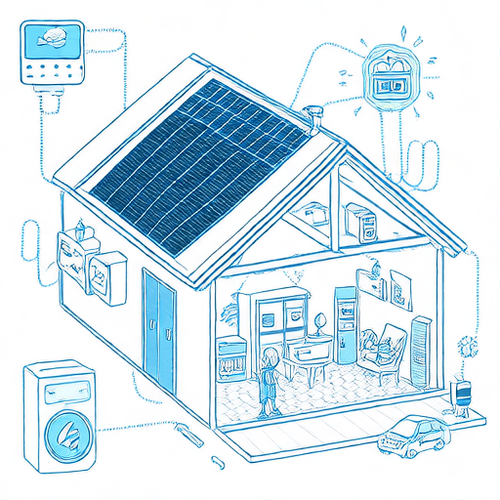Mastering Energy Monitoring with Home Assistant's Energy Dashboard

NGC 224
DIY Smart Home Creator
Mastering Energy Monitoring with Home Assistant's Energy Dashboard
In an era of rising energy costs and growing environmental awareness, understanding your home's energy consumption and production is more crucial than ever. Home Assistant provides a powerful, built-in tool to achieve this: the Energy Dashboard. This feature transforms raw sensor data from various devices into meaningful insights, helping you identify energy vampires, optimize solar usage, and potentially save money.
This article will walk you through setting up and mastering the Home Assistant Energy Dashboard. We'll cover integrating common energy sources, configuring the dashboard for accuracy, and share best practices for maintaining a reliable energy monitoring system.
Why Home Assistant for Energy Monitoring?
While many smart devices offer their own apps for energy tracking, aggregating data from disparate sources (grid meter, solar inverter, battery, individual plugs) into a single, unified view is challenging. Home Assistant excels at this. Its Energy Dashboard provides:
- A single pane of glass for grid consumption, solar production, battery storage, and individual device usage.
- Historical data analysis over days, weeks, months, and years.
- Calculation of net usage (consumed from/fed to grid).
- Tariff configuration to track energy costs.
- Integration with a vast ecosystem of energy-monitoring devices.
Getting Started: Setting up the Energy Dashboard
The Energy Dashboard requires specific sensor entities that report energy usage (in kWh) or power (in W). These sensors need to be configured correctly to provide cumulative energy values. Home Assistant uses these cumulative values to calculate energy consumed or produced over time.
Prerequisites for Sensors
For a sensor entity to be usable in the Energy Dashboard, it typically needs to meet these criteria:
- Report a cumulative energy value, usually in
kWh. Thestate_classattribute should betotalortotal_increasing. - Alternatively, it can report instantaneous power (in
WorkW) and you can use the built-in Integration helper to convert power to energy. - Have appropriate
unit_of_measurement(e.g.,kWh,W). - Have valid
device_class(e.g.,energy,power).
Many devices expose sensors that already meet these requirements, especially energy meters or smart plugs designed for energy monitoring.
Accessing the Energy Dashboard Configuration
Navigate to Settings -> Energy in your Home Assistant sidebar. If you haven't configured it before, you'll see sections to add various energy sources.
Integrating Your Energy Sources
This is where you connect your physical devices to the dashboard. You'll add sensors for:
- Grid Consumption: How much energy your home uses from the grid.
- Solar Production: How much energy your solar panels generate.
- Battery Storage: Energy flowing into and out of a battery system.
- Individual Devices: Specific appliances you want to track.
Examples of Device Integrations:
1. Smart Meters / Utility Meters
Some smart meters can be read directly (e.g., P1 port in Europe). Integrations exist for specific meter types (e.g., DSMR Reader). Often, these provide sensors directly usable in the Energy Dashboard.
# Example configuration.yaml entry for a hypothetical P1 meter integration
# Check specific integration documentation for details.
sensor:
- platform: dsmr_reader
port: /dev/serial/by-id/usb-######
# ... other configurationAlternatively, you might use an external reader device (like an ESPHome-based pulse counter or optical reader) that publishes data via MQTT. Ensure the sensor published via MQTT has the correct attributes (state_class: total_increasing, unit_of_measurement: kWh).
# Example MQTT sensor configuration
sensor:
- platform: mqtt
name: "Grid Total Consumption"
state_topic: "energy/meter/total_consumption"
unit_of_measurement: "kWh"
device_class: "energy"
state_class: "total_increasing"
# ... other parameters2. Solar Inverters
Many solar inverters have Home Assistant integrations (e.g., SolarEdge, Fronius, Enphase, SMA). These integrations typically provide sensors for total energy produced (kWh). Look for a sensor with device_class: energy and state_class: total_increasing.
For inverters with no direct integration, you might be able to poll them via Modbus TCP/RTU (requires a Modbus integration or custom component) or use an external energy meter (like a Shelly 3EM) clamped onto the solar production wire.
3. Battery Systems
Battery integrations (e.g., SolarEdge, select Tesla Powerwall, Growatt) provide sensors for energy charged (from grid/solar) and discharged (to home/grid). Add the appropriate 'Battery From' and 'Battery To' sensors in the Energy Dashboard configuration.
4. Individual Devices (e.g., Smart Plugs, ESPHome)
Smart plugs with energy monitoring (e.g., Shelly, TP-Link Kasa - if using local control) or custom ESPHome devices with energy monitoring chips (like the PZEM-004T or SCT-013 current sensor) can expose energy usage for specific appliances.
If your device only provides instantaneous power (W or kW), you need to convert it to cumulative energy (kWh) using the Home Assistant Integration helper. Go to Settings -> Devices & Services -> Helpers, click 'Create Helper', choose 'Integration - Riemann sum integral'. Select your power sensor and set the unit of measurement to kWh and the method to 'right'. This creates a new energy sensor entity you can add to the Energy Dashboard.
# Example using the Integration helper via configuration.yaml (less common now)
# Use the UI helper creator instead typically
sensor:
- platform: integration
source: sensor.living_room_tv_power # Your power sensor in W or kW
name: living_room_tv_energy
unit_of_measurement: kWh
round: 2
method: right # Or left/trapz depending on sensor behaviorConfiguring the Energy Dashboard Sections
In Settings -> Energy, click the 'Add' button in each section (Grid Consumption, Solar Production, Battery, Individual Devices) and select the appropriate cumulative energy sensors you identified or created.
You can also configure tariffs (including peak/off-peak) and potentially carbon footprint data if available via integrations.
Tips for Accuracy and Reliability
Getting accurate energy data is crucial for meaningful analysis. Here are some best practices:
- Verify Sensor Data: Before adding a sensor to the Energy Dashboard, check its history graph (Developer Tools -> Statistics or History). Does the value increase monotonically (or stay constant) over time? Sudden drops or resets indicate a problem (e.g., device rebooting, integration issue, sensor reporting instantaneous instead of total).
- Understand Cumulative vs. Instantaneous: The Energy Dashboard needs cumulative energy (
kWh). If you only have power (W), use the Integration helper correctly. - Handle Sensor Resets: Some sensors might reset their cumulative value (e.g., daily or on reboot). Sensors with
state_class: total_increasingtell Home Assistant to handle these resets gracefully by assuming the value before the drop was the cumulative total. If your sensor doesn't have this attribute and resets, you might need template sensors or other methods to maintain a running total. - Ensure Stable Communication: Energy monitoring relies on constant data flow. Ensure your devices (Wi-Fi, Zigbee, Z-Wave, ESPHome) have stable connections to Home Assistant. Use a reliable network setup.
- Check Integration Health: Regularly check the logs (Settings -> System -> Logs) for errors related to your energy devices or integrations.
- Address Missing Data: Gaps in recorded data (due to HA downtime, network issues, device failure) will impact the Energy Dashboard's accuracy for those periods. Ensure Home Assistant is running reliably and its Recorder database is healthy.
- Configure Tariffs Correctly: If tracking costs, ensure your peak/off-peak times and prices are set up accurately in the Energy Dashboard configuration. Use template sensors or helpers if your tariffs are complex or change frequently.
- Monitor Grid Net Metering: For homes with solar, ensure your 'Grid Consumption' sensors represent energy *imported* from the grid and 'Grid Return' sensors represent energy *exported* to the grid. Some meters provide separate sensors for this, others provide a net reading. Configure the dashboard accordingly.
Beyond the Dashboard
Once you have reliable energy data, you can leverage it in automations:
- Turn off non-essential devices when grid energy price is high.
- Charge your EV or run dishwashers/washing machines when solar production is high or grid price is low.
- Get notifications if consumption is unusually high or solar production is lower than expected.
# Example automation to notify if grid consumption is high overnight
alias: Notify High Overnight Consumption
description: ''
trigger:
- platform: numeric_state
entity_id: sensor.grid_total_consumption_today # Requires a daily sensor
above: 15 # kWh
at: '06:00:00'
condition:
- condition: time
after: '00:00:00'
before: '06:00:00'
action:
- service: notify.mobile_app_your_phone
data:
message: "High grid consumption detected today: {{ states('sensor.grid_total_consumption_today') }} kWh"
mode: singleConclusion
Setting up and maintaining accurate energy monitoring in Home Assistant requires careful selection and configuration of sensors, but the insights gained are invaluable. The Energy Dashboard provides a clear, unified view of your home's energy flows, empowering you to make informed decisions about your consumption, optimize your solar investment, and build a more efficient smart home. By following best practices for data integrity and sensor reliability, you can trust the information the dashboard provides and unlock the full potential of Home Assistant's energy management capabilities.

NGC 224
Author bio: DIY Smart Home Creator
